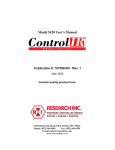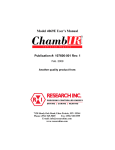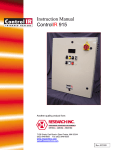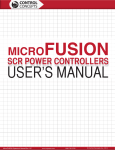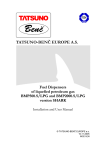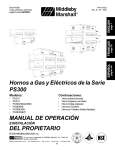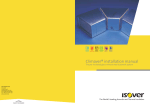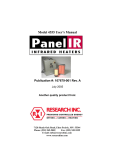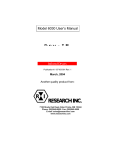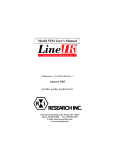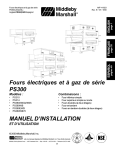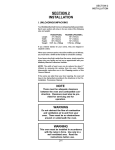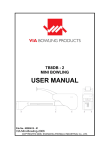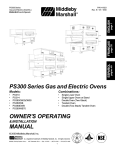Download ControlIR Model 930 User Manual - Precision Control Systems, Inc.
Transcript
Model 930 Power Control System Instruction Manual Publication No. A105328-001 Rev A December 2000 Another quality product from: 7128 Shady Oak Rd, Eden Prairie MN 55344 Phone: (952) 949-9009 Fax: (952) 949-9559 www.researchinc.com Dear Customer: Thank you for purchasing a Model 930 ControlIRTM Power Control System. We believe it is the finest system of its type and are confident you will think so too. For technical assistance, training, replacement parts and assemblies, or any other problems or questions, contact our Field Service specialists. They will do everything they can to help you or will put you in touch with someone who can. This instruction manual has been carefully prepared to make sure you get out of your system all the capabilities we designed and built into it. To tell us how we could make the system, our support of it, or this manual even more useful, we invite your to call our product manager with your suggestions and recommendations. Additional copies of this manual are available at a reasonable cost from our Customer Service Department. Once again, let us welcome you to the growing family of Research, Inc. customers. We look forward to working with you in the future. Sincerely, Terry Nigon President Research Inc. Model 930 ControlIRTM Instruction Manual Section Contents page INTRODUCTION General Description Standard Features Optional Features SAFETY 1 1 2 3 INSTALLATION Mounting the System Wiring Connections Power Wiring Connections Line Connections Load Connections Control Connections Cooling Flow On/Off Relay Output Cooling Flow Switch Interlock Heater Over-Temperature Thermo-switch Interlock Remoter Interlock Switch Heater Open Switch Interlock Remote Setpoint Input Temperature Control Option Connections (Option Codes TCT & TCP) 4 5 6 6 6 6 6 7 7 7 7 8 9 OPERATING INSTRUCTIONS Controls and Indicators Main Disconnect Switch Heater ON/OFF Switch Cooling ON/OFF Switch Heater On Indicator Cooling On Indicator Heater Over Temperature Indicator Lamp-Out, OCT / SCR Indicator Remote/Local Setpoint Switch Local Setpoint Potentiometer Load Volts Indicator (Option Code VM) Temperature Control Option Setup Summary Theory of Operation Principles of SCR Power Control Principles of Phase Angle Control 10 10 10 10 10 10 10 10 11 11 11 12 12 12 12 12 Model 930 ControlIRTM Instruction Manual Contents MAINTENANCE AND TROUBLE SHOOTING Routine Maintenance Troubleshooting Calibration Power Controller Panel Voltmeter Calibration Temperature Controller Option Line Voltage Re-Configuration 16 16 17 17 18 18 19 DIMENSIONS AND SPECIFICATIONS Specifications Dimensions Ordering Information Ordering Example Spare and Replacement Parts 20 22 24 24 25 Model 930 ControlIRTM Instruction Manual Introduction Introduction GENERAL DESCRIPTION Figure 1-1 The Model 930 power control system is a complete power ‘solution’ featuring a number of elements integrated into a single, ready-to-install package. The Model 930 is a three-phase power control system available in two configurations of 120 and 160 Amps at 480 Volts. These systems are ideally suited for many industrial power control applications and have been specifically optimized for use with Research Inc. infrared heating systems. Model 930 Three Phase Power Controller STANDARD FEATURES Research, Inc. Standard features include: • Local 10 turn potentiometer with digital dial for precise manual control of load voltage. • Remote control capability with a 0-5 VDC or 0-20 mA signal. • Heater power switch with remote interlocks. The load voltage may be enabled or disabled without turning off the main disconnect switch. • Heater ON/OFF switch controls an AC contactor to remove power from the SCR controller and the load. • Cooling power switch to control air or water cooling flow. • Cooling flow interlock contacts. Low cooling turns off the heater contactor. • Heater open interlock contacts. A heater open condition turns off the heater contactor. • Heater over temperature contacts. Heater over temperature condition turns off the heater contactor. • Indicators lights for heater on, cooling on, heater over temperature, and SCR fault condition. Page 1 of 25 Model 930 ControlIRTM Instruction Manual Introduction • Fail safe operation of the heater contactor. The contactor will not automatically reenergize after a power failure, or an alarm condition that shuts down the heater. • Programmable Logic Controller for operating and alarm logic control. OPTIONAL FEATURES The following standard options are available: Automatic Temperature Control Option The automatic temperature control option allows the power level to be adjusted based on an entered temperature setting for the process. The temperature controller uses PID type control and is pre-wired for a ‘K’ type thermocouple (option code TCT) or a 4/20mA pyrometer signal (option code TCP). Voltmeter Option The true RMS load voltage is displayed with a digital meter. A true RMS voltage transmitter is provided for isolation and operator safety. Lamp-out Detection Option The lamp out detection option is designed to detect a lamp failure or load loss when using multiple infrared heaters or zones of lamps in a single heater. The SCR fault / Lamp out indicator flashes during this condition. Product Detect “PD” Option The product detect option automatically adjusts the heater or lamp intensity between run and idle states when a product is detected on the conveyor. A single turn idle potentiometer is provided on the front panel. Idling the process saves energy and equipment wear. Research, Inc. Page 2 of 25 Model 930 ControlIRTM Instruction Manual Operating Instructions Safety WARNING! Hazardous voltages are present at the main disconnect switch and load terminals. Setting the setpoint potentiometer or control signal to minimum does NOT eliminate these hazardous voltages. Always remove AC line voltage from the system before making contact with internal assemblies, line or load wiring, or fuses. Also remove AC line voltage from the system before making connections, equipment changes, or resistance measurements. CAUTION! Up to 480 volts AC is present within the power control solution system. Do not make any wiring connections when power is applied. Disconnect power before performing any maintenance or service to the system. Use extreme caution when adjusting calibration potentiometers on modules when power is applied. Always use an isolated oscilloscope for checking waveforms. Research, Inc. Page 3 of 25 Model 930 ControlIRTM Instruction Manual Operating Instructions Installation This section describes how to install and wire the Model 930 power control system. The features and options mentioned here are identified in the model number found inside the enclosure. WARNING! Hazardous voltages are present at the main disconnect switch and load terminals. Setting the setpoint potentiometer or control signal to minimum does NOT eliminate these hazardous voltages. Always remove AC line voltage from the system before making contact with internal assemblies, line or load wiring, or fuses. Also remove AC line voltage from the system before making connections, equipment changes, or resistance measurements. MOUNTING THE SYSTEM Figure 3-1 The Model 930 Power Control System may be mounted to a wall with the supplied brackets, on a stand, or bench. The Model 930 must be mounted in a vertical position. When mounting to a wall, the top of the enclosure should not be over 74 inches (1880 mm) above the floor. Wall Mounting Dimensions The weight of the Model 930 varies slightly with the options installed. The maximum weight of the system is ???. Research, Inc. Page 4 of 25 Model 930 ControlIRTM Instruction Manual WIRING CONNECTIONS Operating Instructions Conduit entry into the system should be made near the right side of the cabinet for power wiring, near the center of the cabinet for load wiring, and near the left side for low voltage control wiring. Assure that metal fragments are not allowed to fall into the equipment while holes are made for conduit fittings. We suggest a separate conduit entry should be made for low level DC control wiring if used. This includes the remote setpoint input or thermocouple wire (temperature control option). Table 3-1 Wiring Specifications Wire Ratings: Wire Temperature Rating: Line/Load Wiring Voltage Rating (240 VAC systems) Line/Load Wiring Voltage Rating (480 VAC systems) Control Wiring 75°C or Higher 300 VAC Minimum 600 VAC Minimum 300 VAC Minimum Allowable Wire Sizes: Current Rating of System Line Connections Load Connections Ground Connection Control Circuit Connections 120 Amp 160 Amp #6-250 MCM #6-250 MCM #6-250 MCM #6-250 MCM #4-1/0 AWG #4-1/0 AWG 22-10 AWG 22-10 AWG Recommended Minimum Wire Sizes: NOTE: Wire temperature and connector ampacity ratings are based on NEC 310-16 using 75°C copper wire derated for 50°C ambient environment. Current Rating of System Line Connections Load Connections Ground Connection Control Circuit Connections 120 Amp 160 Amp 1 AWG 2/0 AWG 6 AWG 4 AWG 6 AWG 6 AWG 16 AWG 16 AWG Electrical Inputs: Heater open interlock switch Cooling flow interlock switch Heater over-temp. thermoswitch Remote interlock switch Research, Inc. Contacts Rated for 120 VAC at 2.0 A Contacts rated for 120 VAC at 100 mA Contacts rated for 120 VAC at 100 mA Contacts rated for 120 VAC at 100 mA Page 5 of 25 Model 930 ControlIRTM Instruction Manual Operating Instructions Power Wiring Connections Line Connections Referring to the wiring specification in Table 3-1, connect the external power lines to the top of the disconnect switch. Load Connections The model 930 power control system has 2 (3-pole) load fuseblocks for distributing the Three-phase power to your process. For the 120 Amp systems, do not exceed more than 60 amps – 3 phase per fuseblock. For the 160 Amp systems, do not exceed more than 80 amps – 3 phase per fuseblock. The heater load should be wired to evenly distribute the number of individual lamps or heating elements to the 2 (three phase) load circuits. It is suggested to balance the load circuits by having the same number and size of lamps or heating elements per phase and per load circuit. Figure 3-2 CONTROL CONNECTIONS Refer to Figure 3-3 for connection of the following items. Cooling Flow On/Off Relay Output This feature provides a normally closed and open (form C) dry contact relay output to control cooling flow. Connect the cooling solenoid /chiller/contactor circuit to TB-100 pins 24 (NC), 25 (COM), 26 (NO) as required. Research, Inc. Page 6 of 25 Model 930 ControlIRTM Instruction Manual Cooling Flow Switch Interlock Operating Instructions This feature provides shutdown of the heater power in case of low or no cooling flow. This is accomplished by opening the heater power controller contactor. The cooling sensor may be a water flow or air flow switch. Use a switch with contacts that are open during the fault condition. Connect the flow switch to TB 100 pins 2 and 3. If both water and air cooling flow switches are used in a system, wire the switches in series and then connect to the system. Heater Over-Temperature Thermo-switch Interlock Remote Interlock Switch Heater Open Switch Interlock This feature provides shutdown of the heater power in case of a heater overtemperature. This is accomplished by opening the heater power controller contactor. If a thermoswitch is not included with your heater, use a thermo-switch with contacts that will open during the over-temperature condition. If this feature is desired or provided with the heater, connect using the following procedure: 1. Remove the factory installed jumper at TB 100 pins 4 and 5. 2. Connect the thermo-switch to TB 100 pins 4 and 5. 3. If more than 1 thermo-switch is used, in a system, wire the switches in series and then connect to the system. This feature provides for remote process interlock shutdown of the heater power. This is accomplished by opening the heater power controller contactor. With the interlock open, the heater can not be turned on from the control system front panel. The switch contacts must be open during the heater off condition. If this feature is desired, connect using the following procedure: 1. Remove the factory installed jumper at TB 100 pins 10 and 11. 2. Connect the normally open contacts of the switch to TB 100 pins 10 and 11. 3. If more than 1 interlock switch is used in a system, wire the contacts in series and then connect to the system. This feature provides shutdown of the heater power if the heater is opened during operation. This switch directly interlocks power to the heater contactor. If a heater cavity open switch is not included with your heater, use a switch with contacts that are open when the heater is open. To implement feature, connect using the following procedure: 1. Remove the factory installed jumper at TB 100 pins 14 and 15. 2. Connect the normally open contacts of the switch to TB 100 pins 14 and 15. 3. If more than 1 heater open interlock switch is used in a system, wire the contacts in series and then connect to the system. NOTE: If a remote Emergency Stop switch is desired, wire the switch (push/pull type with maintained contacts) in series with the heater open switch. Research, Inc. Page 7 of 25 Model 930 ControlIRTM Instruction Manual Remote Setpoint Input Operating Instructions This feature allows the power level of the system to be controlled from a remote location or device. This is accomplished by applying a 0-5 VDC or 0-20 mA signal input from a remote source. This feature is not available when the ‘Temperature Controller’ option is installed. If this feature is desired use the following procedure: 1. For a 0-5 VDC input, connect the source to TB 100 pins 16+ and 17-. 2. For a 0-20 mA input, connect the source to TB 100 pins 16+ and 17-. Also install a 250 ohm resistor across terminals TB 100 16+ and 17-. Figure 3-3 Control Connections Research, Inc. Page 8 of 25 Model 930 ControlIRTM Instruction Manual Temperature Control Option Connections (Option Codes TCT & TCP) Research, Inc. Operating Instructions Temperature control option ‘TCT’ is setup to use a ‘K’ type thermocouple for the temperature input. Temperature control option ‘TCP’ is setup to use a pyrometer for the temperature input. Alarm connections are provided if required for your process. The alarm contacts are ‘dry’ type rated for a maximum of 3 Amps resistive at 240 VAC. If desired the process temperature alarm may be connected to the Front Paned Over-Temp Alarm Indicator. Make connections as follows: 1. ‘TCT’ option: Use ‘K’ type extension wire from the thermocouple to the system connections. Connect the ‘K’ thermocouple extension wire to TB 100 pins 18+ and 19-. 2. ‘TCP’ option: The pyrometer should source the 4-20 mA current through it’s circuitry. If a ‘2 wire’ pyrometer is used, an external power supply must be used. The model 935 does not source current for pyrometer operation. Connect the 4-20mA signal to TB 100 pins 18+ and 19-. 3. ‘TCT’ and ‘TCP’ options: To use the alarm output as an external process alarm. Connect the device for the alarm output to TB100 pins 20 and 21. If a remote alarm output is not used, the alarm may be connected to the front panel over-temp alarm indicator. Connect TB 100 pin 20 to pin 8 and TB 100 pin 4 to pin 11. The alarm indicator will flash while the temperature controller is in an alarm condition. Page 9 of 25 Model 930 ControlIRTM Instruction Manual Operating Instructions Operating Instructions CONTROLS AND INDICATORS Figure 4-1 shows the location of the controls and indicators. Main Disconnect Switch The main disconnect switch turn on and off the power control system. Note the following: Before turning on the disconnect switch, check the following: 1. The load is wired and ready for power to be applied to it. 2. All safety precautions are observed. Heater ON/OFF Switch The Heater ON/OFF switch allows the operator to enable or disable the power going to the load. This is accomplished by removing power from the AC contactor. This in turn removes power from the SCR controller. The cooling on indicator must be on before the heater power can be turned on. Cooling ON/OFF Switch The Cooling ON/OFF switch allows the operator to turn on or off the heater cooling. Heater On Indicator • Indicator light on steady indicates power is applied to the heater power controller. • Indicator light flashing indicates that the Remote Interlock is open and heater power can not be applied. Cooling On Indicator • Indicator light on steady indicates adequate cooling flow. • Indicator light flashing indicates that the cooling is in a one minute shutoff delay cycle. The one minute delay cycle is activated any time that the heater power contactor is opened, after the initial heater on cycle is activated. Heater Over Temperature Indicator • Indicator light on steady indicates a heater over temperature condition. A heater over temperature condition will open the heater power contactor, removing power from the heater. • Indicator light flashing indicates a process over temperature alarm. This feature is available only if the Temperature Control Option is installed. The indicator will flash only as long as the process alarm exists. Lamp-Out, OCT / SCR Indicator • Indicator light on steady indicates a power controller over current (OCT) or a power controller shorted scr (SCR) condition exists. The OCT / SCR alarm will open the heater contactor, removing power from the load. • Indicator light flashing indicates a lamp out condition. This feature is available only if the lamp out (LL) option is installed. The alarm will remain on as long as the lamp out condition exists. Research, Inc. Page 10 of 25 Model 930 ControlIRTM Instruction Manual Operating Instructions The remote/local setpoint switch allows the operator to select the source for the power level setting to the load, lamps, or heaters. The selections include: 1. LOCAL: The power level is adjusted using the digital 10-Turn ‘LOCAL SETPOINT’ potentiometer. Remote/Local Setpoint Switch 2. REMOTE: The power level is controlled from a remote location or device or the power level is controlled by the temperature controller if the TCT/TCP temperature option is installed. The operator will enter a desired temperature setpoint for the process. The power level is adjusted based on the feedback from the temperature sensor connected to the process. Local Setpoint Potentiometer The power level is adjusted using the digital 10-Turn ‘LOCAL SETPOINT’ potentiometer when the ‘Setpoint’ switch is in the ‘Local’ position. Load Volts Indicator (Option Code VM) This option provides indication of the ‘True RMS’ load voltage. Figure 4-1 Controls and Indicators 1 2 1. Disconnect Switch 2. Optional Temperature Controller or Optional Voltmeter 3. Heater On / Off Switch 4. Heater On Indicator 5. Remote / Local Setpoint Switch 6. Local Setpoint Potentiometer 7. Cooling On / Off Switch 8. Cooling On Indicator 9. Heater Over-Temperature Indicator 10. Over Current / Shorted SCR Indicator and Optional Lamp Out Indicator 3 PV 070 SV 4 5 6 Heater Off On Heater On Setpoint Rem Loc Local Cooling Off On Cooling On Heater Overtemp Lamp Out OCT SCR 9 10 7 Research, Inc. 070 8 000 Page 11 of 25 Model 930 ControlIRTM Instruction Manual TEMPERATURE CONTROL OPTION Operating Instructions This section contains temperature controller configuration information for your system. Refer to the Model XT19 installation and instruction manual for operating the temperature controller. Setup Summary Table 4-1 displays factory configurations made for your system: Table 4-1 Sensor Input (TCT option) Sensor Input (TCP option) Control Type: AL 1 (alarm 1): Temperature Controller Configuration ‘K’ type thermocouple scaled 0-2500°F 4-20mA signal scaled 0-2500°F PID (proportional, integral & derivative) Full scale high, non-latching, set for 2000°F (This alarm will trip a relay connected to TB100 pins 13 and 14) Control Output: 0-20 milliamps This alarm may be re-configured as necessary for your process THEORY OF OPERATION Principles of SCR Power Control SCR type power controllers control power by regulating when silicon controlled rectifiers (SCRs) conduct AC line current to the load. A SCR is a solid-state, electronic switching device that turns on (fires) very quickly when a low-level “gating” signal is applied to its gate electrode. The timing of the gating signal, and therefore the length of time the SCR conducts, is determined by the controller’s firing circuitry in response to a control signal. The greater the percentage of time the SCR is on, the greater the average power it allows to pass through to the load. The Model 910 uses a random-fire solid state relay within its SCR poser controller. This relay is a package consisting of 2 SCRs and a gate drive circuit. During the positive half-cycle of the AC line voltage the SCR’s anode is positive with respect to its cathode, so during that half-cycle the SCR will begin to conduct whenever a gating signal is applied to its gate electrode (see figure 4-2). Once turned on, an SCR will continue to conduct until its anode-to-cathode voltage drops to zero, so the SCR continues to conduct until the end of the half-cycle. Figure 4-2 Conduction of one SCR when turned on at the beginning of a half-cycle CATHODE ANODE GATE INPUT LINE VOLTAGE OUTPUT LINE VOLTAGE GATING SIGNAL FIRING CIRCUITRY Research, Inc. CONTROL SIGNAL Page 12 of 25 Model 930 ControlIRTM Instruction Manual Operating Instructions Because an SCR is a type of diode, it can conduct only during every other half-cycle of the applied voltage. Therefore, SCRs used to control AC power are usually installed in pairs, connected in reverse-parallel, as shown in figure 4-3. One of the SCRs then can be fired during the positive half-cycle and the other can be fired during the negative half-cycle. SCR 1 Figure 4-3 Conduction of two SCRs connected in reverse parallel when turned on at the beginning of half-cycles SCR 1 SCR 2 INPUT LINE VOLTAGE SCR 2 OUTPUT LINE VOLTAGE GATING SIGNAL GATING SIGNAL FIRING CIRCUITRY Principles of Phase Angle Control CONTROL SIGNAL In phase angle controllers, the SCRs conduct during all or part of every half-cycle. When delivering full power, the SCRs start conducting at the beginnings of the AC half-cycles. When delivering less than maximum power, the gating signal is de-layed so the SCRs start conducting some time later than the beginnings of the half-cycles. Operation of a phase angle controller at partial output is depicted in figure 4-4. Figure 4-4 Conduction of two SCRs connected in reverse parallel when turned on after the beginning of the half-cycles SCR 1 SCR 1 SCR 2 INPUT LINE VOLTAGE SCR 2 GATING SIGNAL OUTPUT LINE VOLTAGE GATING SIGNAL FIRING CIRCUITRY Research, Inc. CONTROL SIGNAL Page 13 of 25 Model 930 ControlIRTM Instruction Manual Operating Instructions The average power a phase angle controller delivers to its load is determined by the number of electrical degrees by which the gating signal that turns on the SCRs is delayed past the beginnings of the half-cycles. The later in each half-cycle the SCRs fire, the less the time the SCRs conduct during each half-cycle and, therefore, the less power is delivered to the load (see figure 4-5). The 0–5 VDC control signal received by the phase angle firing-circuit determines the amount by which the gating signal is delayed. Figure 4-5 Phase angle power control 135° PHASE ANGLE LOW POWER OUTPUT 0° 90° 180° 270° 360° 90° 180° 270° 360° 90° PHASE ANGLE MEDIUM POWER OUTPUT 0° 90° 180° 270° 360° 90° 180° 270° 360° 90° 180° 270° 360° 45° PHASE ANGLE HIGH POWER OUTPUT 0° 90° 180° 270° 360° AC PHASE ANGLE AC LINE VOLTAGE OUTPUT VOLTAGE TO LOAD Research, Inc. Page 14 of 25 Model 930 ControlIRTM Instruction Manual Operating Instructions The output voltage of a phase angle controller does not change linearly with respect to the number of degrees the SCR conduction phase angle changes. Therefore, the SCR controllers have a built-in load feedback circuit to linearize the relationship between the control signal and the voltage output. The feedback circuit also adjusts the power controller output to compensate for changes in line voltage and load impedance (this is called “line and load regulation”). Phase angle power control offers a number of attractive features. Because the power controller output level is adjusted by varying the SCR on time within each AC halfcycle, the controller’s output is quite constant, rather than being divided into multiplecycle periods of on time and off time. In addition, a variety of feedback and output indication (metering) circuits can easily be incorporated into the controller. Research, Inc. Page 15 of 25 Model 930 ControlIRTM Instruction Manual Maintenance and Trouble Shooting Maintenance and Trouble Shooting ROUTINE MAINTENANCE The following bi-monthly routine maintenance is suggested: 1. Remove power connection to the system. Lock out power if possible. Carefully vacuum any dust or dirt collecting within the enclosure. Use caution to not disturb the wiring. Service more often in dust locations. 2. TROUBLESHOOTING Clean the outside of the enclosure with glass cleaner and a soft cotton cloth as necessary. Symptom Heater Contactor will not energize. Action 1. Verify line voltage is applied to the main disconnect switch. 2. Verify remote heater open, remote process interlocks or water flow switches (if used) are closed. 3. If not using remote heater enable, heater open interlocks or water flow switches, verify the 2 pin jumpers are installed between TB 100 pins 2 to 3, 10 to 11 and 14 to 15. 4. Check fuses FU 1050, FU 1051, FU 107, FU 108 and TB 100 pin 1. No output to load, heaters or lamps. Setpoint switch is in LOCAL mode. 1. Verify the ‘Heater On’ indicator is illuminated. 2. Verify a 0-5 VDC signal is present on pins 13 and 14 of the power controller connector. This voltage is proportional to the setting of the local Setpoint potentiometer or the idle potentiometer (product detect option) if product is not detected. 3. If the over current light on the controller is illuminated, check the load wiring, lamp or heater connections for short circuits. 4. If the shorted SCR light is lit on the controller, refer to the power controller manual regarding repairs. 5. If the COMMAND led on the power controller is not lit and a control signal is greater than 10 percent is applied, refer to the power controller manual regarding repairs. Research, Inc. Page 16 of 25 Model 930 ControlIRTM Instruction Manual Maintenance and Trouble Shooting Symptom No output to load, heaters or lamps. Setpoint switch is in REMOTE. Operation O.K. with Setpoint switch in LOCAL (if not see above). Action 1. Verify the polarity of the remote input. TB 100 pin 16 is positive, and 17 is negative. Full voltage cannot be obtained. 1. Verify the load, lamps, or heaters are not drawing current at full capacity of the system. Rotate the current limit pot on the power controller 1 turn counterclockwise. If the load current decreases, the current limit is controlling the output. 2. Units with Temperature control option: Place temperature controller in manual mode with 50 percent output. Verify 2.5VDC at TB 100 pins 16 and 17. Refer to the temperature controller manual regarding repairs. 2. Verify the line voltage. Load voltage maximum is approximately 98 percent of the line voltage. 3. Test in LOCAL setpoint mode. Set the ‘Local Setpoint’ potentiometer to 900. The voltage should be 216 (240 volt line), or 432 (480 volt line). Adjust the RUN SPAN potentiometer of the power controller as necessary. 4. Faulty power controller SCR or control circuit. Refer to the power controller manual regarding repairs. Load voltage will not go to zero. 1. Verify the load voltage will go to zero with the SCR switch set to DISABLED. If it does not, refer to the power controller manual regarding repairs. 2. If the shorted SCR indicator of the power controller is on, an SCR has failed. 3. Units with the Product Detect option: Normal operation of the idle circuit. The idle potentiometer maintains the voltage at idle. 4. Units with the Conveyor / Web speed option: Normal operation. The minimum idle potentiometer may be adjusted to lower the load voltage to zero if the web is stopped. CALIBRATION Generally components of the power control system hold their calibration very well over a long period of time. Usually verification of calibration is all that is necessary. We suggest verification or calibration be performed on a yearly basis. Calibration should be performed by qualified personnel as dangerous voltages are present. Power Controller Refer to the power controller manual for specific calibration instructions. Calibrate using step 1, 2 or 3 below (use whichever is used most often): 1. When LOCAL setpoint mode is selected, the local setpoint potentiometer is used as the source for the input. Adjust the zero and span potentiometers on the power controller. The SPAN potentiometer is adjusted for 90 percent or rated line voltage for 900 dial divisions of the local setpoint pot. The ZERO potentiometer is adjusted for 0 Volts output when the local setpoint is set to 000 dial divisions. Research, Inc. Page 17 of 25 Model 930 ControlIRTM Instruction Manual Panel Voltmeter Calibration Maintenance and Trouble Shooting 2. Voltmeter Option or No Options: When REMOTE setpoint mode is selected, use a 0-5 VDC source for an input. Adjust the zero and span potentiometers on the power controller. The SPAN potentiometer is adjusted for 90 percent of rated line voltage for 4.5 VDC input. The ZERO potentiometer is adjusted for 0 Volts output when the local setpoint is set to 000 dial divisions. 3. Temperature Controller option only: When AUTO setpoint mode is selected, the temperature controller is used as the source for the input. Adjust the zero and span potentiometers on the power controller. The SPAN potentiometer is adjusted for 90 percent of rated line voltage for 90 percent output of the temperature controller. The ZERO potentiometer is adjusted for 0 volts output when the temperature controller is set to 0 percent. The front panel load voltmeter is calibrated to match as closely as possible the true RMS voltage measured at the load terminals. 1. Connect a true RMS DVM to load 1 and load 2. 2. Connect another DVM across pins 1(+) and 2(-) of the EXT 200 RMS voltage transmitter. 3. Turn the HEATER switch to OFF. Measure the voltage of EXT 200 pins 1(+) and 2(-) to be 0.0 VDC +/- 10 millivolts. Adjust the EXT 200 zero potentiometer if necessary. 4. Verify the panel voltmeter reads 0 volts. If necessary, carefully remove the front cover of the meter and adjust the zero potentiometer for 000 +/- 1 reading. 5. Turn the Heater switch to ON. Adjust the LOCAL SETPOINT potentiometer for the following load voltage based on the voltage your system is configured for: 480 VAC units: 450 VAC 240 VAC units: 225 VAC 6. Measure the voltage of EXT 200 pins 1(+) and 2(-) to be the following voltage +/10 millivolts: 480 VAC units: 3.750 VDC 240 VAC units: 1.875 VDC 7. Temperature Controller Option Research, Inc. Verify that the panel voltmeter reads the voltage as set in Step 5 above. If necessary, carefully remove the front cover of the meter and adjust the span potentiometer for a +/- 1 reading. Refer to the temperature controller manual for calibration instructions. Page 18 of 25 Model 930 ControlIRTM Instruction Manual LINE VOLTAGE RE-CONFIGURATION Maintenance and Trouble Shooting The AC line voltage for the Model 930 Power Control System may be re-configured. On transformer T100, a wire with wire number 1070 is connected to pins 3 or 4. Move this wire to the pin corresponding to the desired line voltage. Pin 3 Pin 4 240 VAC 480 VAC See Figure 5-1 below. Figure 5-1 AC Voltage Tap On transformer T200, it is necessary to re-configure the primary wires per the following (see Figure 5-2): 240VAC Jumper H1 to H3 Jumper H2 to H4 480VAC Jumper H3 to H2 Figure 5-2 T200 Transformer Research, Inc. Page 19 of 25 Model 930 ControlIRTM Instruction Manual Dimensions and Specifications Dimensions and Specifications SPECIFICATIONS Environmental Limits: Operating Temperature Storage Temperature Humidity Clearance 0-50 deg. C (32-122 deg. F) -40-70 deg. C (-10-158 deg. F) 0-90 %, non-condensing 4” (100mm) on right and left sides Weight: The system weight varies slightly with the options installed. The maximum weight of the system is ??? pounds (??? kg). Operating Voltage: 240 or 480-VAC +10%, -15% at 50 or 60 Hertz. Voltage set at factory per order. Operating Current and kW: Maximum Power kW at Current Rating of System Continuous Current Rating at 50°C 120 Amp 160 Amp 120 Amps 160 Amps 240 VAC 50 66.5 Line Fusing: Current Rating of System 120 Amp 160 Amp Fuse Type JJS-150 JJS-200 Fuse Rating Class T 150 Amp 600 Volt Class T 200 Amp 600 Volt 480 VAC 99.8 133 Power Control: Control Mode: SCR phase-angle control of the voltage applied to a three phase load. True RMS voltage feedback for load voltage regulation. Control Range: 0-98% of supply voltage. Output Linearity: RMS load voltage varies linearly with control signal, within +/- 2 percent of span over the entire range of control. Research, Inc. Page 20 of 25 Model 930 ControlIRTM Instruction Manual Dimensions and Specifications Electrical Isolation: Heat sink to supply and load voltage: 2500 Volts peak. Command signal to supply and load voltage: 1400 Volts peak. Slew Rate: 200 ms. Slew rate is the time required for the load voltage to change 63% of the value represented by the command signal. The current limiting action will affect the slew rate if the load current is greater than the current rating of the SCRs. Wiring Specifications Wire Ratings: Wire Temperature Rating: Line/Load Wiring Voltage Rating (240 VAC systems) Line/Load Wiring Voltage Rating (480 VAC systems) Control Wiring Allowable Wire Sizes: Current Line Rating of Connections System 120 Amp 160 Amp #6-250 MCM #6-250 MCM 75°C or Higher 300 VAC Minimum 600 VAC Minimum 300 VAC Minimum Load Connections Ground Connection Control Circuit Connections #6-250 MCM #6-250 MCM #4-1/0 AWG #4-1/0 AWG 22-10 AWG 22-10 AWG Recommended Minimum Wire Sizes: NOTE: Wire temperature and connector ampacity ratings are based on NEC table 310-16 using 75°C copper wire derated for 50°C ambient environment. Current Rating of System Line Connections Load Connections Ground Connection Control Circuit Connections 120 Amp 160 Amp 1 AWG 2/0 AWG 6 AWG 4 AWG 6 AWG 6 AWG 16 AWG 16 AWG Electrical Inputs: Heater open interlock switch Cooling flow interlock switch Heater over-temp. thermo-switch Remote interlock switch Research, Inc. Contacts Rated for 120 VAC at 2.0 A Contacts rated for 120 VAC at 100 mA Contacts rated for 120 VAC at 100 mA Contacts rated for 120 VAC at 100 mA Page 21 of 25 Model 930 ControlIRTM Instruction Manual Dimensions and Specifications Specifications for Options Option Code TCT & TCP Temperature Controller Option Thermocouple type (TCT): Type ‘K’ Sensor Input (TCP): 4-20mA scaled 0-2500 deg. F Alarm relay rating: 5A @ 120VAC resistive, 3A @ 240VAC Sample rate: 10 HZ Calibration accuracy: +/- 0.2% of full scale +/- 1 digit Control modes: PID or PI, PD, P only, or On/Off Temperature stability: 5uV/°C max, 3uV/°C typical Noise Rejection: Common Mode > 100 dB, Series Mode > 70 dB Autotune: Operator initiated Option Code Voltmeter Option RMS Voltage transducer: 0-600 VAC to 0-5 VDC Overall accuracy: +/- 2 VAC VM DIMENSIONS Figure 6-1 displays the overall dimensions of the Model 935 power control system. The dimensions include the side vents and door handle. Figure 6-1 Model 930 Dimensions Overall Research, Inc. Page 22 of 25 Model 930 ControlIRTM Instruction Manual Dimensions and Specifications Figure 6-2 shows the mounting dimensions using the supplied brackets. Figure 6-2 Wall Mounting Dimensions Research, Inc. Page 23 of 25 Model 930 ControlIRTM Instruction Manual Dimensions and Specifications Ordering Information Model Product Description 935 Three Phase SCR Power Control System Code Enclosure A Wall Mount(1) Code Line Voltage 240 240 Volts AC 480 480 Volts AC Code Current Capacity 120 120 Amps 160 160 Amps Code Options (2) Temperature Controller – 4/20 mA, Pyrometer Input (2) Temperature Controller – Thermocouple Input TCP TCT (2) VM Digital Voltmeter LL Lamp-out Detection 00 None (1) (2) Overall Dimensions (including side vents, door handle and mounting brackets): 51.15 inches High (1299.2mm) x 16.34 inches Deep (415mm). System available with either option TCP, TCT or VM. Select one only. Ordering Example Typical Model Number Research, Inc. Model Enclosure Line Voltage Current Capacity 930 A 480 120 Options TCP LL Page 24 of 25 Model 930 ControlIRTM Instruction Manual Dimensions and Specifications Spare and Replacement Parts Description Fuse – 200 Amp 600 VAC (For use with 160 Amp version) Fuse – 150 Amp 600 VAC (For use with 120 Amp version) Fuse – 1 Amp Time Delay "CC" Fuse – 2 Amp 5x20 mm Fast Act. True RMS AC Voltage Transmitter Digital Meter – 0-600 VAC Control Transformer – 70 VA Potentiometer – 1K, 10 Turn Digital Dial Switch – 2 Position Selector (contact blocks separate, see below) Remote/Local Switch – 3 position spring return to center (contact blocks sold separately) Switch – contact block 1 CON NO Switch – contact block 2 CON NO NC Pilot Light Module 120 VAC Model XT19 Temperature Controller (Thermocouple Input) Model XT19 Temperature Controller (4-20mA, Pyrometer Input) Main Disconnect Switch 3P 200A Handle for Disconnect Switch Contactor 3 Pole 200A Model 3629B Power Controller 160A Model 3629B Power Controller 120A Programmable Logic Controller 8AC in 6 Relay out with 915/935-PRJ Software Fuse Load 80A, 600VAC (Load Fuse 120A Version) Fuse Load 100A, 600VAC (Load Fuse 160A Version) Control Transformer 100VA 240/480-120V Research, Inc. Part Number 089330-001 086160-015 086445-015 087146-002 097832-002 097831-005 099366-001 055769-004 042952-000 087543-002 087543-004 087545-001 087545-001 092452-001 097399-002 097399-003 105286-001 105287-001 105289-001 099458-043 099458-041 099559-001 086797-001 086160-010 075475-001 Page 25 of 25





























